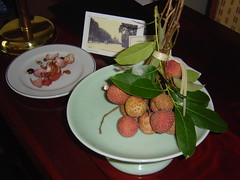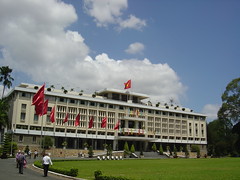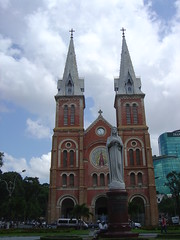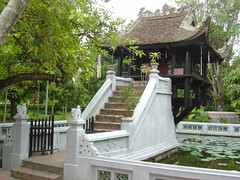One minor obsession we developed on our trip was the need to identify and taste as many different fruit as we could find. One tropical fruit that is actually not uncommon in the US is the lychee. A lychee is about the size of a golf ball with a thin but tough reddish brown skin. The inside is a translucent white and has a small seed in the center.
The taste is very sweet with the texture of canned pears. Canned lychees can be found in better grocery stores and can be bought fresh in the dedicated Asian supermarkets.
In the US, we rarely see the lychee still on the branch with leaves like in this picture. These were a complimentary gift from the Soffitel Metropole in Hanoi. As you can see from the small plate of skin and seeds next to the lychees, we were well into the bunch before we stopped to take a picture.
Tuesday, July 26, 2005
Wednesday, July 20, 2005
Reunification - And Other Euphemisms
Every person in southern and central Vietnam over the age of 40 or so can divide their life into "before 1975" and "after 1975". The use of a calendar marker avoids other politically incorrect descriptions of the fall of South Vietnam to North Vietnam and the reunification of the country under a communist government.
The Reunification Palace is a frozen-in-amber reminder of the years of the Republic of Vietnam. This building in particular is emblammatic of that era. Originally named Independence Palace, it was built in 1966 after the original French colonial building on the site was severly damaged in an assassination attempt on President Ngo Dinh Diem. It ceased being a working government building when North Vietnamese tanks stormed the grounds, symbolizing the collapse of South Vietnam.
The English language tour gives a fairly unbiased history of both the building and South Vietnamese politics. The architecture is Modernist along Frank Lloyd Wright lines with subtle to the point being undetectable Asian accents. The original 1960's and '70's era decor and furnishings give the place the air of a slightly mildewed Austin Powers set.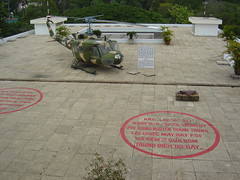
The building itself has developed some mythology around it including the the bad feng shui of the site and the folklore of some poached elephant tusks in the presidential office.
The tableau on the roof has the helicopter that Nguyen Van Thieu used to survey battlefield conditions and marks the locations where two dud bombs dropped by a South Vietnam Air Force defector fell through the roof. Had either bomb detonated, the building would likely have been destroyed.
The Reunification Palace is a frozen-in-amber reminder of the years of the Republic of Vietnam. This building in particular is emblammatic of that era. Originally named Independence Palace, it was built in 1966 after the original French colonial building on the site was severly damaged in an assassination attempt on President Ngo Dinh Diem. It ceased being a working government building when North Vietnamese tanks stormed the grounds, symbolizing the collapse of South Vietnam.
The English language tour gives a fairly unbiased history of both the building and South Vietnamese politics. The architecture is Modernist along Frank Lloyd Wright lines with subtle to the point being undetectable Asian accents. The original 1960's and '70's era decor and furnishings give the place the air of a slightly mildewed Austin Powers set.

The building itself has developed some mythology around it including the the bad feng shui of the site and the folklore of some poached elephant tusks in the presidential office.
The tableau on the roof has the helicopter that Nguyen Van Thieu used to survey battlefield conditions and marks the locations where two dud bombs dropped by a South Vietnam Air Force defector fell through the roof. Had either bomb detonated, the building would likely have been destroyed.
Sunday, July 17, 2005
History Is Written By The Winners
History is written by the winners. ~Alex Haley
Throughout our trip we would encounter reminders that the United States did not emerge the victor in what the Vietnamese call "The American War." In fact, both the United States and Vietnam came out of that conflict battered and scarred, metaphorically and literally.
Both my wife and I have strong family connections to people who served in the war. I have met people who spent time as prisoners of war. The bravery and commitment of any American who serves his country in armed conflict cannot be dishonored.
This post does not have any pictures accompanying it because there were many things we did not take pictures of. Anytime we encountered displays of destroyed American military equipment, we realized that there was American blood on exhibit. Out of respect to the over 160,000 Americans who gave their lives in service to their country, we do not have pictures of places memorializing the killing of Americans.
Throughout our trip we would encounter reminders that the United States did not emerge the victor in what the Vietnamese call "The American War." In fact, both the United States and Vietnam came out of that conflict battered and scarred, metaphorically and literally.
Both my wife and I have strong family connections to people who served in the war. I have met people who spent time as prisoners of war. The bravery and commitment of any American who serves his country in armed conflict cannot be dishonored.
This post does not have any pictures accompanying it because there were many things we did not take pictures of. Anytime we encountered displays of destroyed American military equipment, we realized that there was American blood on exhibit. Out of respect to the over 160,000 Americans who gave their lives in service to their country, we do not have pictures of places memorializing the killing of Americans.
Friday, July 15, 2005
Not That Notre Dame
Not all the houses of worship in Vietnam are Buddhist. The Cathedral of Notre Dame in Saigon is a good bit plainer than it's more famous cousin in Paris, but it does serve Saigon's small but significant Catholic population.
Vietnam has the second largest population, behind the Philippines, of Catholics in Asia. Officially, Vietnam has religious freedom, but the Catholic churches we saw in the northern region had either been abandoned or converted to secular purposes after the French left the country and many northern Catholics fled to South Vietnam.
One morning, while walking past Notre Dame, I say a group of about five nuns on there way to Mass wearing blue ao dai's and matching wimples. The ao dai, which is a very practical but formfitting type of formal clothing was also frequently worn by waitresses, store clerks and other women in the tourist district.
Vietnam has the second largest population, behind the Philippines, of Catholics in Asia. Officially, Vietnam has religious freedom, but the Catholic churches we saw in the northern region had either been abandoned or converted to secular purposes after the French left the country and many northern Catholics fled to South Vietnam.
One morning, while walking past Notre Dame, I say a group of about five nuns on there way to Mass wearing blue ao dai's and matching wimples. The ao dai, which is a very practical but formfitting type of formal clothing was also frequently worn by waitresses, store clerks and other women in the tourist district.
Thanks to Ann Tours
Throughout our trip to Vietnam, we relied on a great private tour company called Ann Tours. We wanted to see a lot of Vietnam in a fairly brief time frame and they worked hard to get us a custom designed tour including hotels, excursions, guides, and airport transportation.
In particular, Tony, the son of the founder, gave great personalized service. With the miracle of the internet, we would e-mail questions or requests in the evening and have detailed responses when we awoke the next day.
This great attention to detail carried over when we arrived in Vietnam. We were met at the airport for each leg of our trip and had a private van for all our touring with an English-speaking guide. We had three different guides in all and each had a unique perspective on both contemporary and historical Vietnam.
I would definitely recommend a private tour company, and Ann Tours in particular, for anyone wanting to see Vietnam.
In particular, Tony, the son of the founder, gave great personalized service. With the miracle of the internet, we would e-mail questions or requests in the evening and have detailed responses when we awoke the next day.
This great attention to detail carried over when we arrived in Vietnam. We were met at the airport for each leg of our trip and had a private van for all our touring with an English-speaking guide. We had three different guides in all and each had a unique perspective on both contemporary and historical Vietnam.
I would definitely recommend a private tour company, and Ann Tours in particular, for anyone wanting to see Vietnam.
Thursday, July 14, 2005
Temples and Tombs Part II
This Buddhist temple is a supported on a single pillar in the middle of a pond, hence the name of One Pillar Pagoda. Like many historical buildings in Hanoi and Vietnam in general, it is not original. The original one at this location dates to 1049. The current one was rebuilt at a smaller scale in 1955 after being destroyed by the French.
Wednesday, July 13, 2005
Temples and Tombs
 Whenever people travel to Europe, I joke about there being nothing to see except castles and cathedrals. Well, the Asian equivalents are temples and tombs. In 14 days, we saw some of both.
Whenever people travel to Europe, I joke about there being nothing to see except castles and cathedrals. Well, the Asian equivalents are temples and tombs. In 14 days, we saw some of both.This picture was taken at the Temple of Literature in Hanoi. The temple was founded in 1070 and dedicated to Confucius. It is the oldest education facility in Vietnam. For centuries it was the university for scholars aspiring to become to officials at the royal court.
 It is still used by students today to make prayers and offerings for good luck on their exams. The incense in this dragon altar was placed there by college age students that were about to start exams that week.
It is still used by students today to make prayers and offerings for good luck on their exams. The incense in this dragon altar was placed there by college age students that were about to start exams that week.For more information about the Temple, click this link.
Tuesday, July 12, 2005
Money Talk
One of the interesting aspects of visiting both Vietnam, a developing socialist country, and Japan, a modern industrial power, in the same trip is the ability to contrast the two cultures and economies.
Well, the currency is a great place to start. Vietnam has obviously had at least one round of hyperinflation in the past since the conversion rate between the dong (VND) and the dollar (US$) is 15,000 to one. The actual government set rate is around 15,800 to 1, but most merchants and stores round down to 15,000 in their benefit any chance they get.
The smallest denomination of currency is the 1,000 VND note (~US$0.07), although coins are more common in this range. The largest note is for 100,000 VND (~US$6.50) and bills for 5,000, 10,000, 20,000 and 50,000 VND are also very common. The problem is that with all the zeroes on the currency, telling them apart requires more concentration than it should. Pulling out a 50,000 VND bill when you want a 5,000 and vice versa happened way too often.
The relatively small value of the biggest bill was not that big of a problem since relatively few things cost more than 100,000 VND. A bowl of pho (a popular meal-sized soup) cost around 20,0000 VND (~US$1.50). At most small cafes, a meal for three got change from a single 100,000 bill.
For bigger purchases, and many smaller ones, US currency was accepted and even preferred. Some merchants would only quote dollars to obvious foreigners like myself. This policy is officially frowned upon, but nearly ubiquitous. I was able to buy 7 arcade game tokens with a single one dollar bill. The price of a high quality silk tie was US$5 nearly everywhere. A little money went a long way in most circumstances.
Japan, on the other hand, was a completely different story. Japan deservedly has a reputation as a very expensive country and the currency reflects it. The yen has been pretty steady for many years at about 110 yen to the dollar. Once you embrace the concept of a yen being about a penny, everything makes sense (no pun intended).
The smallest available bill is the 1,000 yen note (~US$10). It's a little unnerving to buy a soft drink from a fast food place with the equivalent of a ten dollar bill and only get change back. The 500 yen coin seems to be a relatively new item since many vending machines couldn't or wouldn't accept it.
As I left the country, my goal was to spend all the 100 yen coins I had accummulated over the few days I was there. With soft drinks and candy snacks at about 150 yen each, or about as much as a whole meal did in Vietnam, that didn't take long.
So in summary, the smallest bill in Japan is worth more than the largest bill in Vietnam. And the dong goes a lot further than the yen.
Well, the currency is a great place to start. Vietnam has obviously had at least one round of hyperinflation in the past since the conversion rate between the dong (VND) and the dollar (US$) is 15,000 to one. The actual government set rate is around 15,800 to 1, but most merchants and stores round down to 15,000 in their benefit any chance they get.
The smallest denomination of currency is the 1,000 VND note (~US$0.07), although coins are more common in this range. The largest note is for 100,000 VND (~US$6.50) and bills for 5,000, 10,000, 20,000 and 50,000 VND are also very common. The problem is that with all the zeroes on the currency, telling them apart requires more concentration than it should. Pulling out a 50,000 VND bill when you want a 5,000 and vice versa happened way too often.
The relatively small value of the biggest bill was not that big of a problem since relatively few things cost more than 100,000 VND. A bowl of pho (a popular meal-sized soup) cost around 20,0000 VND (~US$1.50). At most small cafes, a meal for three got change from a single 100,000 bill.
For bigger purchases, and many smaller ones, US currency was accepted and even preferred. Some merchants would only quote dollars to obvious foreigners like myself. This policy is officially frowned upon, but nearly ubiquitous. I was able to buy 7 arcade game tokens with a single one dollar bill. The price of a high quality silk tie was US$5 nearly everywhere. A little money went a long way in most circumstances.
Japan, on the other hand, was a completely different story. Japan deservedly has a reputation as a very expensive country and the currency reflects it. The yen has been pretty steady for many years at about 110 yen to the dollar. Once you embrace the concept of a yen being about a penny, everything makes sense (no pun intended).
The smallest available bill is the 1,000 yen note (~US$10). It's a little unnerving to buy a soft drink from a fast food place with the equivalent of a ten dollar bill and only get change back. The 500 yen coin seems to be a relatively new item since many vending machines couldn't or wouldn't accept it.
As I left the country, my goal was to spend all the 100 yen coins I had accummulated over the few days I was there. With soft drinks and candy snacks at about 150 yen each, or about as much as a whole meal did in Vietnam, that didn't take long.
So in summary, the smallest bill in Japan is worth more than the largest bill in Vietnam. And the dong goes a lot further than the yen.
Monday, July 11, 2005
Vietnam and Japan Trip
My family took a trip to Vietnam and Japan this year. This blog will contain thoughts and impressions about that trip including, hopefully, pictures and images. This is not meant to be a diary since the trip is already over. Instead it will be more observations that I find interesting. All opinions are mine and all material is coprighted by me unless credited otherwise.
Subscribe to:
Comments (Atom)
